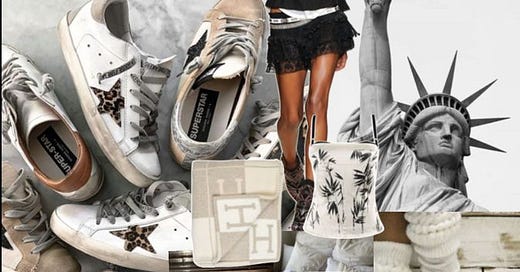Death of the aspirational customer
Individualism is in, aspirational uniformity is out, the middle class is shrinking, and consumers are splitting into two camps. There’s a lot to unpack.
Today’s essay is on the death of the aspirational customer.
Once the darlings of marketing teams and the cornerstone of brand growth, aspirational customers shaped entire industries and (believe it or not) helped the likes of Blake Lively become household-name status.
But fast forward to 2025, and the story has taken a turn.
Today, we’re witnessing the quiet (yet significant) death of the aspirational customer.
In 2024, the luxury sector lost 50 million customers, largely due to aspirational buyers pulling back. Their spending dropped by 20% year-on-year, according to Vogue Business.
I’ll be discussing why this is all happening:
Who aspirational customers are (or were)
Why consumer behaviour is shifting
The decline of the middle class (and why it matters)
What this means for marketers
And finally, my advice for staying relevant
Settle in.
Understanding aspirational customers
Aspirational customers have long been the bread and butter of luxury marketing, those who aspired to a lifestyle just out of reach, and expressed that ambition through spending.
They didn’t just buy products; they bought into identity, status, and dreams.
Remember Gossip Girl?
Blake Lively’s Serena van der Woodsen wasn’t just television royalty, she became a global archetype of aspiration: tousled hair, effortless glamour, and an “enviable” wardrobe.
Her real-life partnerships with luxury houses quickly followed suit.
Brand collaborations that defined an era:
Chanel: In 2011, Blake fronted the Mademoiselle handbag line. Chanel wasn’t just selling bags, it was selling Serena’s lifestyle.
Gucci: A year later, she became the face of Gucci's Première fragrance. She secured a reported $4 million contract to front the line's perfumes.
L’Oréal Paris: Appointed global ambassador in 2013, Blake’s influence saw increased brand affinity and growth among millennial consumers.
Why Blake? Well, it wasn’t Blake but it was her character Serena, who represented something important to a lot of women and girls: that upper east side life.
And brands caught on quick.
A Nielsen insights report from 2014 showed a 20% lift in purchase intent among aspirational audiences exposed to celebrity-endorsed campaigns.
And then the shift started:
Today's shoppers aren’t buying the fantasy quite like they used to in the 2000s.
Why?
Conscious consumerism: They’re are looking for transparency, sustainability, and ethics. They care about where the clothes are coming from and how much workers are being paid.
Economic reality check: With rising living costs and stagnant wages, people are choosing utility over status. That £3,000 handbag now looks like six months’ energy bills.
Rise of the individual: Social media has democratised style. TikTok and Instagram have made it cool to have personal taste over brand logos. Individualism is in, and aspirational uniformity is out.
To paint an even bigger picture of the current economic situation:
“Inflation has fallen significantly since hitting 11.1% in October 2022, which was the highest rate for 40 years. However, that doesn't mean prices are falling - just that they are rising less quickly. Inflation soared in 2022 because oil and gas were in greater demand after the Covid pandemic, and energy prices surged again when Russia invaded Ukraine. It then remained well above the 2% target partly because of higher food prices,” reported the BBC.
I digress.
The death of the middle class plays a huge role:
The conversation around the death of the middle class isn’t new, it’s been around for the better part of two decades. But in 2025, it’s no longer just a topic for think tank panels and economic op-eds. It's deeply personal.
The Resolution Foundation reported a 10% drop over the past decade in adults who identify as middle class. Rising rents, unaffordable homes, and low pay have redefined what it means to be “comfortable.”
And this is influencing how they shop.
Another important point to note is the economy's impact on the next generation: Gen Z and Gen Alpha. Marketers are constantly targeting them in campaigns, but do they have the money to buy?
Graduate jobs, once a hallmark of middle-class mobility, are losing their premium.
According to the Resolution Foundation, starting salaries for recent graduates have declined by 4% in real terms over the past two decades, while the minimum wage has risen by 60%.
Today, a graduate in publishing, charity, or journalism may be earning barely more than a full-time minimum-wage worker stacking shelves.
The premium on education has eroded, and with it, the promise of upward mobility.
One person that has written extensively about this is
Implications for marketers:
Consumers are dividing into two camps, those still spending freely (often the ultra-wealthy), and those cutting back drastically.
A one-size-fits-all approach for campaigns? Not possible.
1.) The ‘It Girl’
For decades, the It Girl has shaped brand strategy. “She” has been the face of aspiration, Paris Hilton in the 2000s, Blake Lively in the 2010s, and more recently, Hailey Bieber with the “clean girl” aesthetic. A curated image of lifestyle perfection: effortless beauty, expensive minimalism, and a wardrobe designed to signal status. But in 2025, the consumer has changed, and the aspirational image is losing its power.
Now, its time for customer stories, UGC, behind-the-scenes content, community features.
Consumers are more informed, and more sceptical. They know when they’re being sold a dream. And they’re choosing substance over shine. 71% of Gen Z say they’re more likely to buy from brands that reflect their reality — not a curated, unattainable ideal (McKinsey, 2023).
2.) Lead with values, not vanity
Performative branding doesn’t convert. Consumers no longer care about who you’ve paid to front your campaign. They care about why you exist and what you really stand for. Your values shouldn’t be tucked away in a mission statement. They should shape product decisions, inform marketing strategy, and be visible at every customer touchpoint, from packaging to partnerships.
What this looks like in practice:
Transparent sourcing and ethical supply chains, clearly communicated, not hidden in PDFs.
Actionable DEI strategies with public accountability.
Digestible ESG or sustainability reporting that makes complexity human and visual.
3.) Modern audiences don’t fit neatly into a demographic box.
They’re multilingual, multi-hyphenate, and deeply intersectional, and they expect brand messaging to reflect that complexity. Forget rigid personas. Today’s consumer is fluid, in identity, interests, and platform behaviour.
The solution here is to build modular messaging that meets people where they are, across culture, context, and continent.
How?
Inclusive campaign structures with adjustable narratives.
Messaging frameworks built around shared values, not stereotypes.
Platforms that allow for co-creation, participation, and feedback loops.
Well, that’s it from me.
Please let me know your thoughts in the comments.
Until next time, keep listening, keep learning, and keep evolving.
And make sure you digress often. Curiosity is key to winning in this game.
Charlotte
if you missed last week’s newsletter








« Forget rigidity in personas », yes louder for the people in the back!
Could not agree more. I’m sending this to my team so they can see that our brand is ahead of the game with wild opportunities coming! Thank you for this great piece!